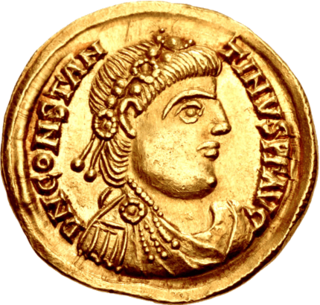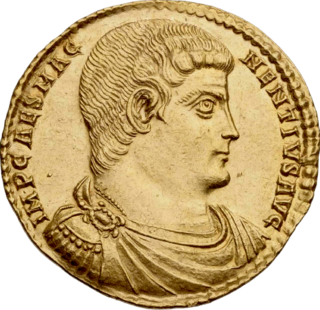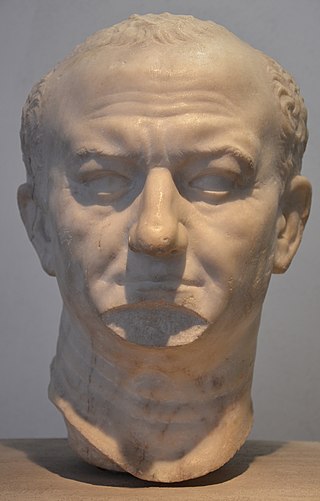Constantine II (emperor)
Last updated| Constantine II | |||||||||
|---|---|---|---|---|---|---|---|---|---|
 Statue of Caesar Constantine II on top of the Cordonata (the monumental staircase climbing up to Piazza del Campidoglio), in Rome | |||||||||
| Roman emperor | |||||||||
| Augustus | 9 September 337 – 340 (Gaul, Hispania, and Britain) | ||||||||
| Predecessor | Constantine I | ||||||||
| Successor | Constans | ||||||||
| Co-emperors | Constantius II (East) Constans (Italy and Africa) | ||||||||
| Caesar | 1 March 317 – 9 September 337 | ||||||||
| Born | 316 Arelate, Viennensis | ||||||||
| Died | 340 (aged 24) Aquileia, Italy | ||||||||
| |||||||||
| Dynasty | Constantinian | ||||||||
| Father | Constantine the Great | ||||||||
| Mother | Fausta | ||||||||
| Religion | Christianity | ||||||||
Constantine II (Latin : Flavius Claudius Constantinus; 316 – 340) was Roman emperor from 337 to 340. Son of Constantine the Great and co-emperor alongside his brothers, his attempt to exert his perceived rights of primogeniture led to his death in a failed invasion of Italy in 340.
Contents
Career
The eldest son of Constantine the Great and Fausta, [lower-alpha 1] Constantine II was born in Arles in 316 and raised as a Christian. [3]
Caesar
On 1 March 317, he was made caesar. [3] [1] Constantine II usually resided with his father, such as accompanying him on his campaign against the Sarmatians in 323, [4] until his own court was installed at Trier in 328. [5] An inscription dated to 328-330 [lower-alpha 2] records the title of Alamannicus, indicating that his generals won a victory over the Alamanni. [3] His military career continued when Constantine I made him field commander during the 332 winter campaign against the Goths. [3] [7] The military operation was successful and decisive, with 100,000 Goths reportedly slain and the surrender of the ruler Ariaric. [8] Festival games were initiated in Rome to celebrate the Caesar’s role in the successful military campaigns, in a public advertisement of his capability to rule. [9] He was married prior to 336, although his wife’s identity remains unknown. [10]
While Constantine I had intended for his sons to rule together with their cousins Dalmatius and Hannibalianus, soon after his death in May 337 the army slaughtered almost all of their male relatives, including Dalmatius and Hannibalianus. [11] Burgess observed from numismatic evidence that Constantine II and his brothers “not only seem not to have fully accepted the legitimacy of Dalmatius and viewed him as an interloper, but also appear to have communicated with one another on this point and agreed on a common response.” [12]
In what seemed to be an attempt to distance themselves from the massacre, [13] the three brothers proceeded to print coins of Theodora, whom their murdered relatives had been descended from. [11] The evidence indicates that Constantine II was the one responsible for designing and producing the coinage at the start, as well as convincing his brothers to do the same. [14] Woods considered it to suggest that he was more sympathetic to Theodora’s memory than his brothers, [15] possibly because his wife may have been a granddaughter of Theodora. [10]
In June 337, before he was named emperor, Constantine had already begun attempting to assert his seniority. [16] He issued an order allowing the exiled bishop Athanasius to return to Alexandria, claiming to be carrying out the unfulfilled intentions of his father. [3] [17]
Augustus
The three brothers were not named as Augusti until 9 September 337, [1] when they gathered together in Pannonia [3] and divided the Roman territories among themselves. Constantine received Gaul, Britannia and Hispania. [18] [19] Unlike his younger brothers, he gained little from Dalmatius’ removal. [20]
Constantine was evidently left unsatisfied with the results of their meeting, [21] [9] seemingly believing that his age granted him some sort of seniority in the imperial college [7] and, by extension, control over the dominion of his youngest brother Constans, who was still a teenager in 337. [17] [22] Even after campaigning successfully against the Alamanni in 338, he continued to maintain his position. [17] [22] [23] The Codex Theodosianus recorded Constantine’s legislative intervention in Constans’ territory through issuing an edict to the proconsul of Africa in 339. [17] [22]
In 340, Constantine launched an invasion into Italy to claim territory from Constans. [17] [3] Constans, at that time in Naissus, [21] sent a number of troops to confront him, and Constantine was killed in an ambush near Aquileia. [17] [24] [lower-alpha 3] Constans then took control of his deceased brother's realm, who seem to have been largely unaffected by their change in ruler. [26] After his death, Constantine was subjected to damnatio memoriae, [17] which his other brother Constantius II also followed. [22]
Family tree
| |||||||||||||||||||||||||||||||||||||||||||||||||||||||||||||||||||||||||||||||||||||||||||||||||||||||||||||||||||||||||||||||||||||||||||||||||||||||||||||||||||||||||||||||||||||||||||||||||||||||||||||||||||||||||||||||||||||||||||||||||||||||||||||||||||||||||||||||||||||||||||||||||||||||||||||||||||||||||||||||||||||||||||||||||||||||||||||||||||||||||||||||||||||||||||||||||||||||||||||||||||||||||||||||||||||||||||||||||||||||||||||||||||||||||||||||||||||||||||||||||||||||||||||||||||||||||||||||||||||||||||||||||||||||||||||||||||||||||||||||||||||||||||||||||||||||||||||||||||||||||||||||||||||||||||||||||||||||||||||||||||||||||||||||||||||||||||||||||||||||||||||||||||||||||||||||||||||||||||||||||||||||||||||||||||||||||||||||||||||||||||||||||||||||||||||||||||||||||||||||||||||||||||||||||||||||||||||||||||||||||||||||||||||||||||||||||||||||||||||||||||||||||||||||||||||||||||||||||||||||||||||||||||||||||||||||||||||||||||||||||||||||||||||||||||||||||||||||||||||||
| Family of Constantine II (emperor) | |||||||||||||||||||||||||||||||||||||||||||||||||||||||||||||||||||||||||||||||||||||||||||||||||||||||||||||||||||||||||||||||||||||||||||||||||||||||||||||||||||||||||||||||||||||||||||||||||||||||||||||||||||||||||||||||||||||||||||||||||||||||||||||||||||||||||||||||||||||||||||||||||||||||||||||||||||||||||||||||||||||||||||||||||||||||||||||||||||||||||||||||||||||||||||||||||||||||||||||||||||||||||||||||||||||||||||||||||||||||||||||||||||||||||||||||||||||||||||||||||||||||||||||||||||||||||||||||||||||||||||||||||||||||||||||||||||||||||||||||||||||||||||||||||||||||||||||||||||||||||||||||||||||||||||||||||||||||||||||||||||||||||||||||||||||||||||||||||||||||||||||||||||||||||||||||||||||||||||||||
|---|---|---|---|---|---|---|---|---|---|---|---|---|---|---|---|---|---|---|---|---|---|---|---|---|---|---|---|---|---|---|---|---|---|---|---|---|---|---|---|---|---|---|---|---|---|---|---|---|---|---|---|---|---|---|---|---|---|---|---|---|---|---|---|---|---|---|---|---|---|---|---|---|---|---|---|---|---|---|---|---|---|---|---|---|---|---|---|---|---|---|---|---|---|---|---|---|---|---|---|---|---|---|---|---|---|---|---|---|---|---|---|---|---|---|---|---|---|---|---|---|---|---|---|---|---|---|---|---|---|---|---|---|---|---|---|---|---|---|---|---|---|---|---|---|---|---|---|---|---|---|---|---|---|---|---|---|---|---|---|---|---|---|---|---|---|---|---|---|---|---|---|---|---|---|---|---|---|---|---|---|---|---|---|---|---|---|---|---|---|---|---|---|---|---|---|---|---|---|---|---|---|---|---|---|---|---|---|---|---|---|---|---|---|---|---|---|---|---|---|---|---|---|---|---|---|---|---|---|---|---|---|---|---|---|---|---|---|---|---|---|---|---|---|---|---|---|---|---|---|---|---|---|---|---|---|---|---|---|---|---|---|---|---|---|---|---|---|---|---|---|---|---|---|---|---|---|---|---|---|---|---|---|---|---|---|---|---|---|---|---|---|---|---|---|---|---|---|---|---|---|---|---|---|---|---|---|---|---|---|---|---|---|---|---|---|---|---|---|---|---|---|---|---|---|---|---|---|---|---|---|---|---|---|---|---|---|---|---|---|---|---|---|---|---|---|---|---|---|---|---|---|---|---|---|---|---|---|---|---|---|---|---|---|---|---|---|---|---|---|---|---|---|---|---|---|---|---|---|---|---|---|---|---|---|---|---|---|---|---|---|---|---|---|---|---|---|---|---|---|---|---|---|---|---|---|---|---|---|---|---|---|---|---|---|---|---|---|---|---|---|---|---|---|---|---|---|---|---|---|---|---|---|---|---|---|---|---|---|---|---|---|---|---|---|---|---|---|---|---|---|---|---|---|---|---|---|---|---|---|---|---|---|---|---|---|---|---|---|---|---|---|---|---|---|---|---|---|---|---|---|---|---|---|---|---|---|---|---|---|---|---|---|---|---|---|---|---|---|---|---|---|---|---|---|---|---|---|---|---|---|---|---|---|---|---|---|---|---|---|---|---|---|---|---|---|---|---|---|---|---|---|---|---|---|---|---|---|---|---|---|---|---|---|---|---|---|---|---|---|---|---|---|---|---|---|---|---|---|---|---|---|---|---|---|---|---|---|---|---|---|---|---|---|---|---|---|---|---|---|---|---|---|---|---|---|---|---|---|---|---|---|---|---|---|---|---|---|---|---|---|---|---|---|---|---|---|---|---|---|---|---|---|---|---|---|---|---|---|---|---|---|---|---|---|---|---|---|---|---|---|---|---|---|---|---|---|---|---|---|---|---|---|---|---|---|---|---|---|---|---|---|---|---|---|---|---|---|---|---|---|---|---|---|---|---|---|---|---|---|---|---|---|---|---|---|---|---|---|---|---|---|---|---|---|---|---|---|---|---|---|---|---|---|---|---|---|---|---|---|---|---|---|---|---|---|---|---|---|---|---|---|---|---|---|---|---|---|---|---|
Emperors are shown with a rounded-corner border with their dates as Augusti, names with a thicker border appear in both sections 1: Constantine's parents and half-siblings
| |||||||||||||||||||||||||||||||||||||||||||||||||||||||||||||||||||||||||||||||||||||||||||||||||||||||||||||||||||||||||||||||||||||||||||||||||||||||||||||||||||||||||||||||||||||||||||||||||||||||||||||||||||||||||||||||||||||||||||||||||||||||||||||||||||||||||||||||||||||||||||||||||||||||||||||||||||||||||||||||||||||||||||||||||||||||||||||||||||||||||||||||||||||||||||||||||||||||||||||||||||||||||||||||||||||||||||||||||||||||||||||||||||||||||||||||||||||||||||||||||||||||||||||||||||||||||||||||||||||||||||||||||||||||||||||||||||||||||||||||||||||||||||||||||||||||||||||||||||||||||||||||||||||||||||||||||||||||||||||||||||||||||||||||||||||||||||||||||||||||||||||||||||||||||||||||||||||||||||||||
Gallery
- Coin of Constantine II as caesar, marked: d·n·fl·cl· constantinus nob·c· ("Our Lord Flavius Claudius Constantine, Noblest Caesar")
- Aureus of Constantine II as caesar, marked: constantinus iun·nob·c· ("Constantine Junior, Noblest Caesar") on the obverse and virtus caesar n· ("the Virtue of Our Caesar") on the reverse
- Coin of Constantine II as augustus.
- Division of the Roman Empire among the Caesars appointed by Constantine I: from west to east, the territories of Constantine II, Constans, Dalmatius and Constantius II.
Notes
- ↑ The PLRE’s statement that Constantine II was not Fausta’s son [1] is wrong. [2]
- ↑ Barnes favors the date 330, [4] while Drinkwater prefers an earlier date of 328-9. [6]
- ↑ In a confused account, Zosimus does not say Constantine II invaded his youngest brother’s territory. He instead reported that Constans sent troops to Constantine on the pretext of assisting in the Persian war, but in reality to assassinate him by surprise. Constans’ troops would’ve been marching away from the Persians if they were heading to Constantine’s territory. [9] [25] Modern historians, trying to make sense of Zosimus’ confusion, have suggested that instead it was Constantine who claimed to be assisting Constantius II. [17] [22] [9]
Related Research Articles

Constantius II was Roman emperor from 337 to 361. His reign saw constant warfare on the borders against the Sasanian Empire and Germanic peoples, while internally the Roman Empire went through repeated civil wars, court intrigues, and usurpations. His religious policies inflamed domestic conflicts that would continue after his death.

Flavius Julius Constans, also called Constans I, was Roman emperor from 337 to 350. He held the imperial rank of caesar from 333, and was the youngest son of Constantine the Great.
The 330s decade ran from January 1, 330, to December 31, 339.

Year 335 (CCCXXXV) was a common year starting on Wednesday of the Julian calendar. At the time, it was known as the Year of the Consulship of Constantius and Albinus. The denomination 335 for this year has been used since the early medieval period, when the Anno Domini calendar era became the prevalent method in Europe for naming years.

Flavius Valerius Constantius, also called Constantius I, was a Roman emperor from 305 to 306. He was one of the four original members of the Tetrarchy established by Diocletian, first serving as caesar from 293 to 305 and then ruling as augustus until his death. Constantius was also father of Constantine the Great, the first Christian emperor of Rome. The nickname "Chlorus" was first popularized by Byzantine-era historians and not used during the emperor's lifetime.

Constantine III was a common Roman soldier who was declared emperor in Roman Britain in 407 and established himself in Gaul. He was recognised as co-emperor of the Roman Empire from 409 until 411.

Magnus Magnentius was a Roman general and usurper against Constantius II. Of Germanic descent, Magnentius served with distinction in Gaul under the emperor Constans. On 18 January 350 Magnentius was acclaimed Augustus. Quickly killing the unpopular Constans, Magnentius gained control over most of the Western Empire. The Eastern emperor Constantius II, the brother of Constans, refused to acknowledge Magnentius' legitimacy and led a successful campaign against Magnentius. Ultimately, Magnentius' forces were scattered after the Battle of Mons Seleucus, and he committed suicide on 10 August 353.

Flavius Claudius Constantius Gallus was a statesman and ruler in the eastern provinces of the Roman Empire from 351 to 354, as Caesar under emperor Constantius II, his cousin. A grandson of emperor Constantius Chlorus and empress Flavia Maximiana Theodora, and a son of Julius Constantius and Galla, he belonged to the Constantinian dynasty. Born during the reign of his uncle Constantine the Great, he was among the few male members of the imperial family to survive the purge that followed Constantine's death. Under Constantius II, Gallus served as deputy emperor, based in Antioch and married to Constantius' sister Constantina. He dealt with a Jewish revolt in the years 351-352. Gallus ultimately fell out of favor with Constantius and was executed, being replaced as Caesar by his younger half-brother Julian.

Constans II was the son of Western Roman emperor Constantine III, and served as his co-emperor from 409 to 411. Constans was a monk prior to his father being acclaimed emperor by the army in Britain in early 407, an act of rebellion against the ruling emperor Honorius. He was summoned to Gaul, appointed to the position of caesar (heir) and swiftly married so that a dynasty could be founded. In Hispania, Honorius's relatives rose in 408 and expelled Constantine's administration. An army under the generals Constans and Gerontius was sent to deal with this and Constantine's authority was re-established. Honorius acknowledged Constantine as co-emperor in early 409 and Constantine immediately raised Constans to the position of augustus (emperor), theoretically equal in rank to Honorius as well as to Constantine. Later in 409 Gerontius rebelled, proclaimed his client Maximus emperor and incited barbarian groups in Gaul to rise up. Constans was sent to quash the revolt, but was defeated and withdrew to Arles. In 410, Constans was sent to Hispania again. Gerontius had strengthened his army with barbarians and defeated Constans; the latter withdrew north and was defeated again and killed at Vienne early in 411. Gerontius then besieged Constantine in Arles and killed him.

The gens Flavia was a plebeian family at ancient Rome. Its members are first mentioned during the last three centuries of the Republic. The first of the Flavii to achieve prominence was Marcus Flavius, tribune of the plebs in 327 and 323 BC; however, no Flavius attained the consulship until Gaius Flavius Fimbria in 104 BC. The gens became illustrious during the first century AD, when the family of the Flavii Sabini claimed the imperial dignity.
(Flavius) Julius Constantius was a member of the Constantinian dynasty, being a son of Emperor Constantius Chlorus and his wife Flavia Maximiana Theodora, a younger half-brother of Emperor Constantine the Great and the father of Emperor Julian.
Flavius Dalmatius, also known as Dalmatius the Censor, was a censor (333), and a member of the Constantinian dynasty, which ruled over the Roman Empire at the beginning of the 4th century.
The Battle of Mursa was fought on 28 September 351 between the eastern Roman armies led by the Emperor Constantius II and the western forces supporting the usurper Magnentius. It took place at Mursa, near the Via Militaris in the province of Pannonia. The battle, one of the bloodiest in Roman history, was a pyrrhic victory for Constantius.

Aurelius Valerius Valens, rarely enumerated as Valens I, was briefly Roman emperor from late 316 to early 317. He was proclaimed emperor by Licinius, emperor of the East, during his war against Constantine I, emperor of the West.

Flavia Valeria Constantina, later known as Saint Constance, was the eldest daughter of Roman emperor Constantine the Great and his second wife Fausta, daughter of Emperor Maximian. Constantina may have received the title of Augusta from her father, and is venerated as a saint, having developed a medieval legend wildly at variance with what is known of her actual character.

Flavius Hannibalianus was a member of the Constantinian dynasty, which ruled over the Roman Empire in the 4th century AD.

The Constantinian dynasty is an informal name for the ruling family of the Roman Empire from Constantius Chlorus to the death of Julian in 363. It is named after its most famous member, Constantine the Great, who became the sole ruler of the empire in 324. The dynasty is also called Neo-Flavian because every Constantinian emperor bore the name Flavius, similarly to the rulers of the first Flavian dynasty in the 1st century.

Flavius Dalmatius Caesar was a Caesar (335–337) of the Roman Empire, and member of the Constantinian dynasty.

This article chronicles the attested movements of the fourth-century Roman emperors Constantine II, Constantius II, Constans, Gallus, and Julian the Apostate from 337 to 361 AD. It does not cover the imperial usurpers of the period, including Magnentius, Vetranio, Claudius Silvanus, and Poemenius. The chronology is principally derived from Timothy Barnes' Athanasius and Constantius. Substantial additions and further sources are based on recent research that seeks to go beyond Barnes' own chronology and slightly modifying his at a few places.
Claudia was the purported mother of Roman emperor Constantius Chlorus according to ancient sources. These sources claim her to be a relative of Roman emperors Claudius Gothicus and Quintillus, a claim modern historians tend to view with suspicion.
References
- 1 2 3 4 Jones, Martindale & Morris, p. 223.
- ↑ Barnes 1973, pp. 36–37.
- 1 2 3 4 5 6 7 DiMaio Jr, Michael; Frakes, Robert (2 May 1998). "Constantine II (337–340 A.D.)". De Imperatoribus Romanis - Online Encyclopedia of Roman Emperors.
- 1 2 Barnes 1982, p. 84.
- ↑ Barnes 1981, p. 221.
- ↑ Drinkwater 2007, pp. 198–199.
- 1 2 Crawford 2016, “Preparation for the Purple: Constantius’ Upbringing and Accession”.
- ↑ Barnes 1981, p. 250.
- 1 2 3 4 Baker-Brian 2022, “Making and Shaping a Dynasty”.
- 1 2 Woods 2011, p. 195.
- 1 2 Hunt 1998, p. 3.
- ↑ Burgess 2008, pp. 21–22.
- ↑ Woods 2011, pp. 194–195.
- ↑ Burgess 2008, p. 23.
- ↑ Woods 2011, p. 194.
- ↑ Lewis 2020, p. 69.
- 1 2 3 4 5 6 7 8 Hunt 1998, p. 5.
- ↑ "Constantine II – Roman Emperor". Encyclopedia Britannica. 2021.
- ↑ Hunt 1998, p. 4.
- ↑ Lewis 2020, p. 59.
- 1 2 DiMaio 1988, p. 240.
- 1 2 3 4 5 Crawford 2016, “Fraternal Civil War and the Usurpation of Magnentius”.
- ↑ Drinkwater 2007, p. 199.
- ↑ DiMaio 1988, p. 241.
- ↑ Lewis 2020, p. 78.
- ↑ Hunt 1998, pp. 5–6.
Sources
Primary sources
- Zosimus, Historia Nova, Book 2 Historia Nova
- Aurelius Victor, Epitome de Caesaribus
- Eutropius, Breviarium ab urbe condita
Secondary sources
- Baker-Brian, Nicholas (2022). The Reign of Constantius II. Taylor & Francis. ISBN 978-1-0006-1991-1.
- Barnes, T. D. (7 December 1973). "Lactantius and Constantine". The Journal of Roman Studies. 63: 29–46. doi:10.2307/299163. JSTOR 299163. S2CID 163051414.
- Barnes, Timothy D. (1981). Constantine and Eusebius. Cambridge, MA: Harvard University Press. ISBN 978-0-674-16531-1.
- Barnes, Timothy D. (1982). The New Empire of Diocletian and Constantine. Cambridge, MA: Harvard University Press. doi:10.4159/harvard.9780674280670. ISBN 0-674-28066-0.
- Burgess, R.W. (2008). "THE SUMMER OF BLOOD: The "Great Massacre" of 337 and the Promotion of the Sons of Constantine". Dumbarton Oaks Papers. 62: 5–51. JSTOR 20788042.
- Crawford, Peter (2016). Constantius II: Usurpers, Eunuchs, and the Antichrist. Pen & Sword. ISBN 978-1-78340-055-3.
- DiMaio, Michael, and Robert Frakes, "Constantine II (337–340 A.D.)", D.I.R.
- DiMaio, Michael (23 January 1988). "Smoke in the Wind : Zonaras' Use of Philostorgius, Zosimus, John of Antioch, and John of Rhodes in His Narrative on the Neo-Flavian Emperors". Byzantion. 58 (1): 230–255. JSTOR 44171050.
- Drinkwater, John F. (2007). The Alamanni and Rome 213–496. Caracalla to Clovis. Oxford: Oxford University Press. ISBN 978-0-19-929568-5.
- Hunt, David (1998). "The successors of Constantine". In Averil Cameron & Peter Garnsey (eds.). The Cambridge Ancient History XIII: The Late Empire, A.D. 337–425. Cambridge University Press. ISBN 0-521-30200-5.
- Jones, A.H.M.; J.R. Martindale & J. Morris (1971). The Prosopography of the Later Roman Empire Volume 1: A.D. 260–395. Cambridge University Press. ISBN 0-521-07233-6.
- Lewis, William (2020). "Constantine II and His Brothers: The Civil War of AD 340". In Nicholas Baker-Brian; Shaun Tougher (eds.). The Sons of Constantine, AD 337–361: In the Shadows of Constantine and Julian. Springer International Publishing. pp. 57–94. ISBN 978-3-0303-9898-9.
- Woods, David (2011). "Numismatic Evidence and the Succession to Constantine I". The Numismatic Chronicle. 171: 187–196. JSTOR 42667233.
- Gibbon, Edward. Decline & Fall of the Roman Empire (1888)




